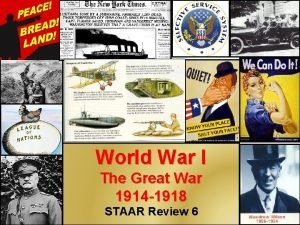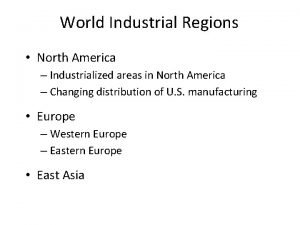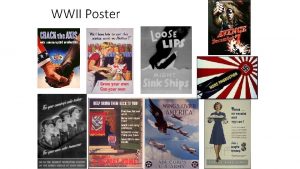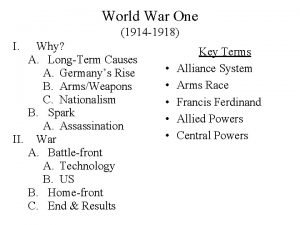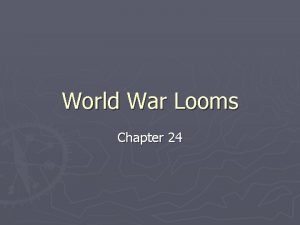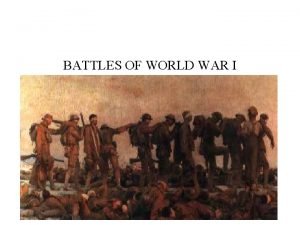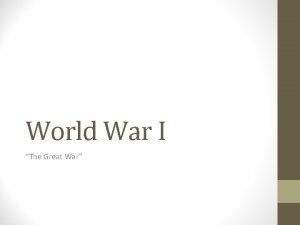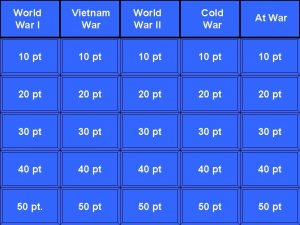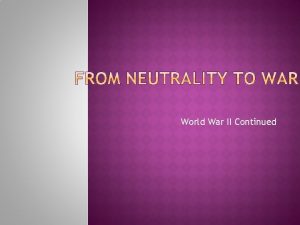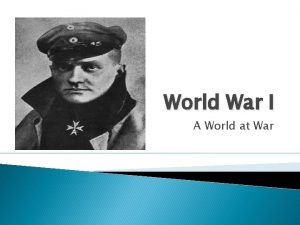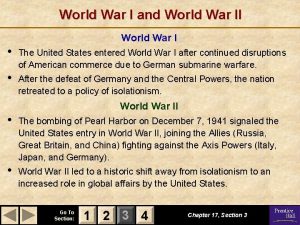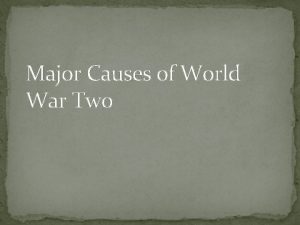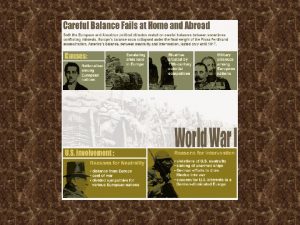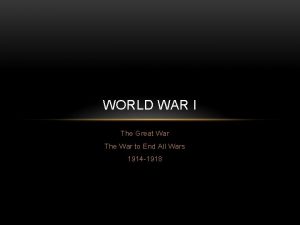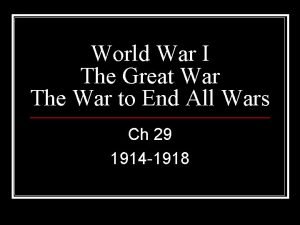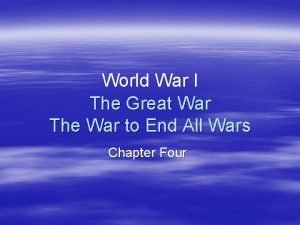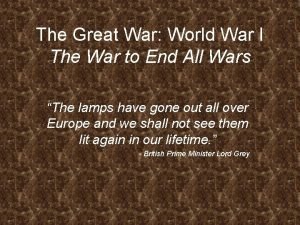World War II Major Engagements PreAmerican Engagements Fall


























- Slides: 26

World War II Major Engagements

Pre-American Engagements Fall of France l June 22, 1940 – – France signs armistice with Germany French leaders (Charles de Gaulle) escaped to Britain and organized “Free French” forces

Pre-American Engagements Battle of Britain l June-October 1940 – Hitler expected Britain to quickly make peace following fall of France l – Hitler sent Luftwaffe (German Airforce) to destroy Royal Air Force l l l – – British refused to surrender Accidentally bombed London British were enraged, bombed Berlin Luftwaffe stops attacking Royal Air Force and start bombing London Hitler’s goal was to terrorize the British into surrender (The Blitz) Following great loss, Hitler cancels invasion of Britain on October 12, 1940

Pre-American Engagements Operation Barbarossa l Launched June 22, 1941 – Attack army of 4 million l – Goal was to reach oil-fields around Caspian Sea l – Also wanted to eliminate Stalingrad Huge military mistake l – Three pronged attack For next 3 years, 90% of German deaths would happen on Eastern front Ends the non-aggression pact

US Joins War- December, 1941

The allied Powers l The Big Three – – – Great Britain (Winston Churchill) The U. S. (FDR) The Soviet Union (Joseph Stalin)

The Two theatres: strategies European Theatre: Strategy: Move in from South through Italy, while squeezing from East and West Allies Decide to Start Here Pacific Theatre: Strategy: Island Hopping towards Japan. Take strategic islands large enough for airfields to protect shipping lanes and stage bombing raids

Europe: North Africa- Nov. 1942 l l l Germans are pushing east, attempting to take Suez Canal from British Defeated at El Alamein by Sir. Gen. Bernard Montgomery (British) Why Important: maintained Allied control of Suez Canal, and prevented German access to oil in the Middle East

Europe: Stalingrad l l l May-November, 1942 Soviets let Germans take city, but then surround it, cutting off German supplies. Starved them out. Nearly ½ million soldiers died on each side Why Important: Changes German actions from offensive to defensive (Germans retreating)

Europe: Taking Italy l July 10, 1943 – Following fall of Sicily, King of Italy surrenders to Allies l Mussolini – deposed Germans hold Rome until May 1944, when they retreat

Operation Overlord (D-Day) l l l The Allies needed to establish a second front to enable the “squeeze” of Germany General Dwight Eisenhower launched an invasion of Normandy on June 6, 1944 An invasion fleet of some 4, 000 ships and 150, 000 men (57, 000 U. S. ) Invasion successful. 5, 000 killed and wounded Allied troops. MUCH MORE SUCCESSFUL THAN ANTICIPATED! It allowed them to gain a foothold on the continent from which they could push Germany back Why did it work? ?


Race to Berlin l l l D-Day was the turning point on the Western Front. Stalingrad was the turning point on the Eastern Front The British, US, and Free French armies began to press into western Germany as the Soviets invaded eastern Germany Both sides were racing to Berlin

The Battle of the Bulge l December 16, 1944 – – Germans attempted one last offensive Surprise attack on swift moving Americans l l – Caused a bulge in American lines. US troops surrounded at city of Bastogne Patton eventually surrounds German army l causes over 100 K casualties to Germans

Victory in Europe (V-E Day) l Mussolini was captured and killed by the Italian people l With Berlin surrounded, Hitler commits suicide on April 30, 1945 l Germany surrenders unconditionally on May 7, 1945

The Pacific Theatre l The Battle of Midway: June 4, 1942 – – – Japanese wanted Midway as a base to attack Pearl Harbor again Americans break Japanese code and know they are coming U. S. Admiral Chester Nimitz caught the Japanese by surprise and sank 3 of the 4 aircraft carriers, 332 planes, and 3500 men.

Importance of Midway l The Japanese defeat at Midway was the turning point in the Pacific. – – – l Japanese advances stopped. U. S. assumes initiative. Japanese have shortage of able pilots. Censorship and Propaganda – – News of the defeat was kept from the Japanese public. Japanese people are consistently told that they are winning

American island hopping

The Beginning of the end in the Pacific l Yamamoto (Japanese admiral) is assassinated by the U. S. (April 1943) l Loss of Saipan (August 1944) – – “the naval and military heart and brain of Japanese defense strategy” Political crisis in Japan l The government could no longer hide the fact that they were losing the war. l Tōjō resigns on July 18, 1944

Iwo Jima l February 1945 – Key Japanese airfield, l – – – would allow US fighter planes to protect bombers on raids of Japan Island full of Japanese soldiers (22, 000) who are dug in Japanese troops refused to surrender, fewer than 1, 000 Japanese troops surrender Became a publicity tool for war-bonds (flag and soldier tours- Ira Hayes)

A Grinding war in the pacific l In 1945, the U. S. began targeting people in order to coerce Japan to surrender – – l l 66 major Japanese cities bombed 500, 000 civilians killed Battle for Leyte Gulf Okinawa (April, 1945)

The Potsdam declaration l July, 1945 – – – Roosevelt is dead- Truman is now President War in Europe is Over Declaration that said Japan must surrender unconditionally l Japanese disagree because they want Hirohito (emperor) to stay in power

Atom diplomacy l l 1941 - FDR funds the top-secret Manhattan Project to develop an atomic bomb- Led by Dr. J. Robert Oppenheimer Bomb tested in the summer of 1945. Decision to drop bomb was left to Harry Truman. An amphibious invasion of Japan could cost over 350, 000 Allied casualties.

US Drops the bombs l August 6, 1945 – Enola Gay drops bomb on Hiroshima – l August 9, 1945 – Nagasaki – l 140, 000 dead; tens of thousands injured; radiation sickness; 80% of buildings destroyed 70, 000 dead; 60, 000 injured Emperor Hirohito surrenders on Aug. 14, 1945. (V-J Day) – Formal surrender signed on September 2 onboard the battleship Missouri in Tokyo Bay

Cost of War l l l Germany- 3 million combat deaths (3/4 ths on the eastern front) Japan – over 1. 5 combat deaths; 900, 000 civilians dead Soviet Union - 13 million combat deaths U. S. – 300, 000 combat deaths, over 100, 000 other deaths When you include all combat and civilian deaths, World War II becomes the most destructive war in history with estimates as high as 60 million, including 25 million Russians.

Postwar Efforts at Revenge l The Nuremberg Trials of 1945 -46 – – – After, WWII the Allied powers decided to place on trial the highest-ranking Nazi officers for “crimes against humanity” Allied forces had attempted to do this after WWI, but had released them on the grounds that they “were just following orders” Hitler, Goebbels, and Himmler were dead; but, 22 Nazi leaders (including Goring) were tried at an international military tribunal at Nuremburg, Germany. 12 were sentenced to death. Similar trials occurred in the east and throughout the world.
 Standards for attestation engagements
Standards for attestation engagements Les 5 engagements de pôle emploi
Les 5 engagements de pôle emploi Coordinated engagements
Coordinated engagements 4 causes for ww1
4 causes for ww1 Things fall apart thesis statements
Things fall apart thesis statements What challenges did madison face abroad
What challenges did madison face abroad Description
Description The cold war lesson 1
The cold war lesson 1 Presidential and radical reconstruction venn diagram
Presidential and radical reconstruction venn diagram Josette dugas war of 1812
Josette dugas war of 1812 Sein datid
Sein datid Study jams force and motion
Study jams force and motion Why was the civil war the first modern war
Why was the civil war the first modern war Bringen simple past
Bringen simple past Chapter 16 lesson 2 challenges to slavery
Chapter 16 lesson 2 challenges to slavery Proxy wars cold war
Proxy wars cold war Chapter 30 the war to end war
Chapter 30 the war to end war Chapter 30 the war to end war
Chapter 30 the war to end war World history semester 2 review
World history semester 2 review World history fall final review answers
World history fall final review answers Mariculture is
Mariculture is Major mountain ranges world map
Major mountain ranges world map Industrial regions in north america
Industrial regions in north america Judaism founder
Judaism founder Propaganda poster techniques
Propaganda poster techniques Results of the world war 1
Results of the world war 1 Building vocabulary world war looms
Building vocabulary world war looms



